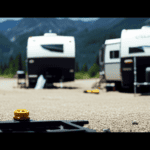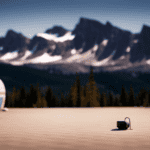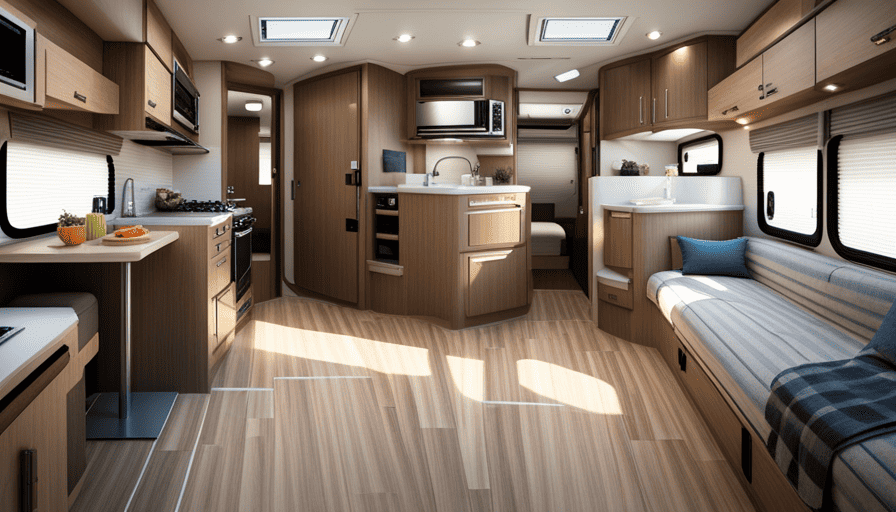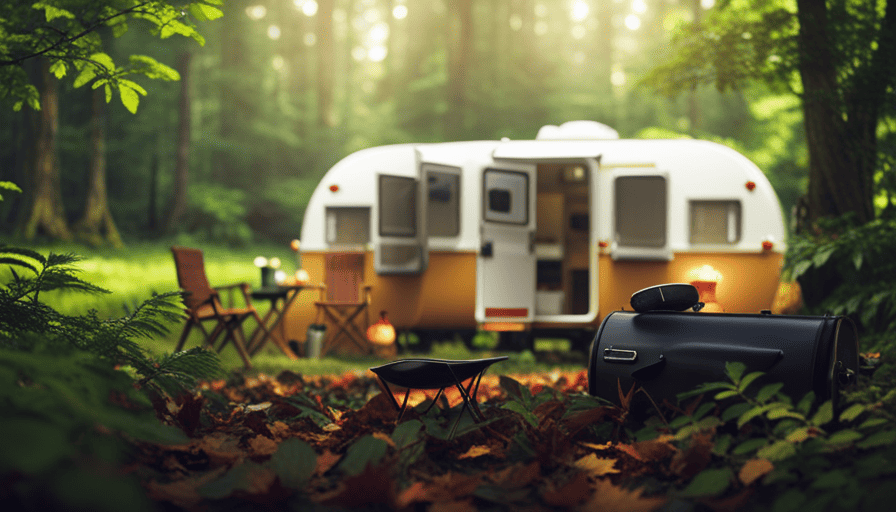Curiously, every time I go on a camping trip with my pop-up camper, I come across the same issue – getting it properly leveled. Experienced campers know that leveling a camper is not just for comfort; it is essential for stability and safety. It ensures that all appliances work smoothly and allows for a restful night’s sleep without the fear of rolling out of bed.
Over the years, I have perfected the art of leveling my pop up camper, and I’m here to share my knowledge with you. In this article, I will walk you through the step-by-step process of leveling a pop up camper, from finding the perfect spot to securing the stabilizers and leveling blocks.
So, grab your tools and let’s get started on making your camping experience as comfortable and stable as possible.
Key Takeaways
- Leveling a pop up camper is important for comfort, stability, and safety.
- The process of leveling involves finding a level spot and using tools like a bubble level and wooden blocks.
- Common leveling mistakes include not checking after adjustments, using insufficient blocks or chocks, and relying solely on the tongue jack.
- Properly securing stabilizers and leveling blocks is essential for a successful camping adventure.
Understanding the Importance of Leveling
So, you’re ready to level your pop-up camper and enjoy a comfortable camping experience, but do you know why leveling is so important? Well, let me tell you.
The importance of balance cannot be overstated when it comes to a pop-up camper. Not only does it ensure your comfort inside the camper, but it also prevents any damage to the structure. When a camper is not level, it puts unnecessary strain on the frame and can cause things to shift and break. This is why leveling techniques are crucial.
To level your pop-up camper, you’ll need to gather the necessary tools and materials. But before we get into that, let’s talk about why leveling is important.
When your camper is level, it allows for even weight distribution, which means you won’t have to worry about things shifting or falling over inside. Additionally, a level camper ensures that your appliances, like your refrigerator, will work properly.
So, now that you understand the importance of leveling, let’s move on to gathering the necessary tools and materials.
Gather the Necessary Tools and Materials
First, you’ll need to gather all the essential tools and materials you’ll need for this task, like a trusty leveler and sturdy wooden blocks. Choosing the right leveling tools is crucial to ensure that your pop-up camper is properly leveled.
A bubble level is a handy tool that can be easily attached to the camper’s side or placed on a countertop inside. It will indicate whether the camper is level or not. Sturdy wooden blocks are also essential for leveling on uneven terrain. These blocks can be placed under the wheels or stabilizing jacks to raise or lower certain areas of the camper.
When leveling on uneven terrain, it’s important to park your camper on the highest point of the site and then use the blocks to level the wheels or jacks. This will help prevent any unnecessary strain on your camper’s frame.
Once you have gathered all the necessary tools and materials, it’s time to find a suitable leveling spot.
Find a Suitable Leveling Spot
Now, let me show you how to discover the perfect spot to set up your camper and ensure a smooth and hassle-free camping experience.
The first step is to find a level ground for your pop-up camper. This is crucial to avoid any discomfort or instability while inside. Look for an area that’s flat and even, preferably without any rocks or debris that could cause an uneven surface.
To accurately determine if the ground is level, I highly recommend using a leveling app on your smartphone. These apps utilize the phone’s built-in sensors to measure the pitch and roll of the surface, giving you precise readings. Simply place your phone on different areas of the ground, and the app will provide you with real-time information about the levelness.
Once you’ve found a suitable level spot, you can transition into the next section about adjusting the front and rear stabilizers. By following these steps, you can ensure that your pop-up camper is stable and secure, providing a comfortable environment for your camping adventure.
Adjust the Front and Rear Stabilizers
To achieve maximum stability and prevent any wobbling or shaking, make sure to fine-tune the stabilizers at the front and rear of your camper. This will create a rock-solid foundation that will withstand any turbulence or jolts. Adjusting the stabilizers is a crucial step in leveling your pop-up camper and ensuring a comfortable camping experience.
Here are three techniques for adjusting the stabilizers effectively:
-
Start by lowering the front stabilizers until they make contact with the ground. Use a manual crank or an electric motor to make the adjustments. This will help distribute the weight evenly and prevent any tilting or leaning.
-
Once the front stabilizers are in place, proceed to adjust the rear stabilizers. Raise or lower them until they also make firm contact with the ground. This will help level the camper front to back.
-
Finally, go back and double-check the adjustments on both the front and rear stabilizers. Ensure they are secure and tight to provide optimum stability while camping.
By following these leveling techniques and adjusting the stabilizers properly, you can create a solid and level foundation for your pop-up camper.
In the next section, we will discuss how to use leveling blocks or wheel chocks to further enhance stability and prevent any movement.
Use Leveling Blocks or Wheel Chocks
Make sure you utilize leveling blocks or wheel chocks to enhance stability and prevent any unwanted movement while camping. Leveling your pop up camper is essential for a comfortable and safe camping experience.
While front and rear stabilizers help to level the camper vertically, leveling blocks or wheel chocks are used to level it horizontally.
To level your pop up camper using leveling blocks, start by parking your camper on a flat surface. Place the leveling blocks under the tires that need to be raised. Gradually drive your camper onto the blocks until it is level. Use a bubble level or a smartphone app to ensure that the camper is evenly balanced.
Alternatively, you can use wheel chocks to level your camper. Park your camper on a level surface and place the wheel chocks in front and behind the tires that need to be raised. Slowly drive the camper onto the chocks until it is level. Again, use a bubble level or a smartphone app to check the balance.
By using leveling blocks or wheel chocks, you can easily level your pop up camper and ensure a stable camping experience. Once the camper is level, you can proceed to the next step of checking and adjusting the side-to-side leveling.
Transitioning to the next section, it’s important to check and adjust the side-to-side leveling to further stabilize your pop up camper.
Check and Adjust the Side-to-Side Leveling
To ensure that your pop up camper is level and stable, it is essential to check and adjust the side-to-side leveling. This step is crucial in preventing any potential issues caused by an uneven surface.
One of the most common and effective leveling methods is using leveling blocks or wheel chocks. By placing these under the low side of the camper, you can easily raise it until it is level. However, it is important to note that there are some common leveling mistakes that should be avoided. These include not checking the level after making adjustments, not using enough blocks or chocks, or relying solely on the tongue jack for leveling.
To further illustrate the importance of this step, let’s take a look at the following table:
| Common Leveling Mistakes | Correct Leveling Method |
|---|---|
| Not checking after adjustments | Check with a bubble level |
| Insufficient blocks or chocks | Use an adequate number |
| Relying solely on tongue jack | Utilize leveling blocks or wheel chocks |
Once you have checked and adjusted the side-to-side leveling, you can then proceed to fine-tune the leveling using a bubble level. This will ensure that your pop up camper is perfectly balanced and ready for a comfortable camping experience.
Fine-Tune the Leveling Using a Bubble Level
Once you’ve adjusted the side-to-side leveling, you can fine-tune the balance of your camper using a handy bubble level. This small tool is essential for ensuring that your pop-up camper is perfectly level, providing stability and comfort during your camping adventures.
Fine-tuning the leveling process involves making tiny adjustments to achieve that optimal balance. Here are three steps to guide you through the process:
-
Place the bubble level on a flat surface inside your camper, such as the kitchen counter or dining table.
-
Adjust the level by raising or lowering the camper’s stabilizing jacks. Use a wrench or crank to make precise adjustments until the bubble is centered in the level.
-
Repeat this process in different areas of the camper to ensure overall balance. Check the level in the sleeping area, bathroom, and any other spaces that will be occupied.
By fine-tuning the leveling with a bubble level, you can be confident that your pop-up camper is stable and ready to provide a comfortable camping experience.
Now, it’s time to test the stability and make any necessary adjustments for optimal performance.
Test the Stability and Adjust as Needed
Now that you’ve fine-tuned the leveling of your camper using a bubble level, it’s time to test its stability and make any necessary adjustments for an optimal camping experience.
Testing the stability of your pop-up camper is crucial to ensure that it stays level and secure during your trip. There are a few methods you can use to test the stability of your camper.
One method is to simply walk around inside the camper and see if it feels stable and balanced. You can also try sitting on the corners and edges of the camper to see if it wobbles or tips. Additionally, you can use a level app on your smartphone to check the levelness of the camper from different angles.
If you notice any instability or unevenness, you may need to make further adjustments to the leveling blocks or stabilizers. It’s also worth considering alternative solutions such as using additional stabilizing devices or repositioning the camper on your campsite.
Once you’ve tested the stability and made any necessary adjustments, you can proceed to secure the stabilizers and leveling blocks to ensure the camper remains level and secure throughout your camping trip.
Transitioning into the subsequent section about securing the stabilizers and leveling blocks, it’s important to take these steps to guarantee a safe and enjoyable camping experience.
Secure the Stabilizers and Leveling Blocks
After fine-tuning the leveling of your camper, it’s essential to secure the stabilizers and leveling blocks for a stable and secure camping experience. Here are three important steps to follow:
-
Stabilizer Maintenance: Before securing the stabilizers, it’s crucial to inspect them for any signs of damage or wear. Check for loose bolts or rust, and tighten or replace them as needed. Lubricate the moving parts to ensure smooth operation. By properly maintaining your stabilizers, you can enhance their effectiveness and prevent any potential issues during your camping trip.
-
Leveling Alternatives: While leveling blocks are commonly used, there are other alternatives worth considering. One option is using a leveling system, which automatically adjusts the camper’s height to achieve a level position. Another alternative is using a leveling jack, which can be placed under the camper’s frame to lift and level it. These alternatives provide added convenience and precision when leveling your pop-up camper.
-
Secure the Stabilizers and Leveling Blocks: Once you have chosen the appropriate method for leveling, it’s time to secure the stabilizers and leveling blocks in place. Place the blocks beneath the wheels or stabilizers and ensure they are properly aligned. Use a wrench or crank to lower the stabilizers until they make firm contact with the ground. This will provide stability and prevent any movement while inside the camper.
By securing the stabilizers and leveling blocks, you can enjoy a comfortable and stable camping experience.
Enjoy a Comfortable and Stable Camping Experience
Get ready to experience a camping adventure that will make you feel like you’re on cloud nine! When it comes to leveling your pop up camper, it’s essential to ensure a comfortable and stable camping experience. One of the key factors in achieving this is to secure the stabilizers and leveling blocks properly. Once you’ve done that, you can focus on enjoying your time in the great outdoors.
To guarantee a good night’s sleep, make sure your camper is level. Uneven surfaces can lead to discomfort and even rolling out of bed during the night. Use a spirit level to check if your camper is balanced. If it’s not, adjust the stabilizers until it is level. This will ensure that you wake up feeling refreshed and ready for another day of adventure.
When it comes to cooking, a stable surface is crucial for safety and convenience. No one wants their pots and pans sliding off the stove while preparing a meal. Place leveling blocks under the camper’s tires to create a stable foundation. This will prevent any wobbling or movement while cooking, making your camping kitchen feel just like your home kitchen.
To summarize, leveling your pop up camper is vital to enjoy a comfortable sleeping experience and stable cooking. Take the time to secure the stabilizers and leveling blocks properly, and you’ll be rewarded with a camping adventure that exceeds your expectations. So, get out there and start making memories!
| Comfortable Sleeping | Stable Cooking |
|---|---|
| Level camper for a good night’s sleep | Use leveling blocks under tires for stability while cooking |
| Prevent rolling out of bed | Avoid pots and pans sliding off the stove |
| Adjust stabilizers until level | Create a stable foundation |
| Wake up refreshed and ready for adventure | Ensure safety and convenience in the camping kitchen |
Frequently Asked Questions
How do I know if my pop up camper is not level?
If my pop up camper isn’t level, there are several common signs that can indicate this. One sign is that items inside the camper may shift or slide, making it difficult to move around or sleep comfortably.
Additionally, doors and windows may not close properly, causing drafts or leaks. It’s important to level the camper to avoid potential risks such as instability, uneven weight distribution, and damage to the camper’s structure.
Can I use any type of leveling blocks or wheel chocks?
Yes, you can use various types of leveling blocks for pop-up campers. There are different options available, such as stackable blocks, interlocking blocks, and even inflatable leveling blocks. Each type has its pros and cons.
Additionally, using wheel chocks can help stabilize your pop-up camper once it’s level. They prevent any unwanted movement and provide extra support. However, it’s important to choose the right type of wheel chocks that are appropriate for your camper’s weight and size.
What are the consequences of not leveling a pop up camper properly?
The consequences of not leveling a pop-up camper properly can be significant. Improper leveling can lead to stability issues, causing the camper to sway or even tip over. This can result in damage to the camper and potential injury to those inside.
Additionally, an unlevel camper can cause problems with the refrigerator, furnace, and other appliances. Proper leveling is crucial for a safe and enjoyable camping experience, so it’s important to take the time to do it correctly.
How often should I check and adjust the side-to-side leveling?
So, you’re wondering how often you should check and adjust the side-to-side leveling of your pop-up camper, huh? Well, let me tell you, my friend, it’s a matter of utmost importance!
Neglecting proper leveling can lead to a world of trouble. From doors that won’t close to dishes sliding off the counter, it’s a recipe for disaster.
To avoid these calamities, I recommend checking your camper’s side-to-side leveling every time you set up camp. Trust me, it’s worth the extra few minutes to ensure a smooth and enjoyable camping experience.
Is it necessary to secure the stabilizers and leveling blocks once the camper is leveled?
Yes, it is necessary to secure the stabilizers and leveling blocks once the camper is leveled. Using stabilizers and leveling blocks for a pop-up camper has its pros and cons. The stabilizers provide additional support and stability to the camper, reducing movement and sway. However, if they are not properly secured, they can loosen or shift, leading to potential instability. To ensure camper stability, make sure to securely fasten the stabilizers and leveling blocks according to the manufacturer’s instructions.
Conclusion
So there you have it, folks! Leveling a pop up camper may seem like a daunting task, but with the right tools and a little know-how, it can be a breeze.
By following these steps, you’ll ensure a comfortable and stable camping experience every time. So don’t forget to bring your leveling blocks or wheel chocks, and always remember to fine-tune using a trusty bubble level.
With a little practice, you’ll become a leveling pro in no time. Happy camping, and may your adventures be as smooth as a freshly paved road!



















